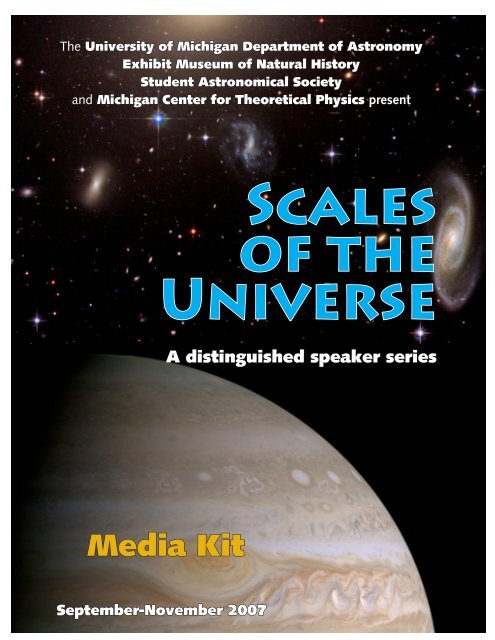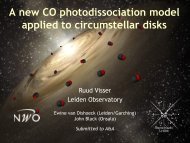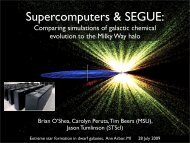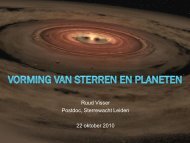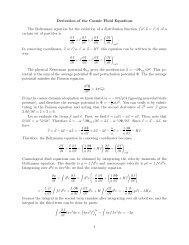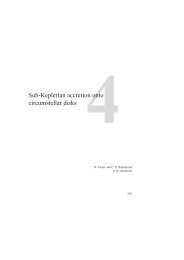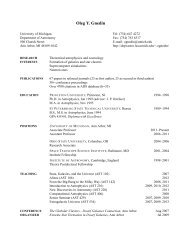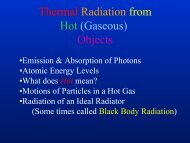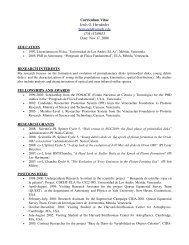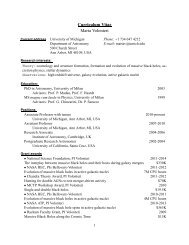Media Kit - Astronomy - University of Michigan
Media Kit - Astronomy - University of Michigan
Media Kit - Astronomy - University of Michigan
- No tags were found...
Create successful ePaper yourself
Turn your PDF publications into a flip-book with our unique Google optimized e-Paper software.
The <strong>University</strong> <strong>of</strong> <strong>Michigan</strong> Department <strong>of</strong> <strong>Astronomy</strong>Exhibit Museum <strong>of</strong> Natural HistoryStudent Astronomical Societyand <strong>Michigan</strong> Center for Theoretical Physics presentScales<strong>of</strong> theUniverseA distinguished speaker series<strong>Media</strong> <strong>Kit</strong>September-November 2007
Scales<strong>of</strong> theUniverseScales <strong>of</strong> the Universe, a distinguished speaker series, will bring some <strong>of</strong> theforemost experts in the field <strong>of</strong> astrophysics to Ann Arbor. The series will be <strong>of</strong>feredthis fall on Friday nights at 7:30 p.m. in room 1800 <strong>of</strong> the Dow Chemistry Building,930 North <strong>University</strong> Avenue on the U-M central campus in Ann Arbor.Scales <strong>of</strong> the Universe examines what the universe is like on a variety <strong>of</strong> spatialscales ranging from the solar system to the entire cosmos itself. The lecturers will als<strong>of</strong>ocus on aspects <strong>of</strong> frontier research at each <strong>of</strong> the featured scales, giving a flavor <strong>of</strong>current astronomical studies in a variety <strong>of</strong> areas. The final lecture will feature theaward <strong>of</strong> the U-M <strong>Astronomy</strong> Department’s Orren C. Mohler Prize, for distinguishedcontributions to astronomy and astrophysics.Please join us for the ultimate in armchair travel! A complete list <strong>of</strong> talksappears below.Friday Taking the measure <strong>of</strong> our John R. SpencerSeptember 28 solar system Southwest Research InstituteFriday Our local microcosmos Carl HeilesOctober 5<strong>University</strong> <strong>of</strong> California, BerkeleyFriday Galaxies: Where space Mario MateoOctober 19 becomes time <strong>University</strong> <strong>of</strong> <strong>Michigan</strong>Friday A rich and evolving tapestry Niel BrandtNovember 2 <strong>of</strong> cosmic structure Pennsylvania State <strong>University</strong>Friday Quarks to the cosmos: Michael S. TurnerNovember 16 Connecting the smallest and <strong>University</strong> <strong>of</strong> Chicagolargest scales
Presented by the U-M Department <strong>of</strong> <strong>Astronomy</strong>, the U-M Exhibit Museum<strong>of</strong> Natural History, the U-M Student Astronomical Society, and the U-M <strong>Michigan</strong>Center for Theoretical Physics.Telescope viewing and planetarium shows will be <strong>of</strong>fered immediatelyfollowing each lecture.For more information, call (734) 764-0478 or (734) 764-3440 or visit www.lsa.umich.edu/exhibitmuseum or www.astro.lsa.umich.edu. For images, contactDan Madaj at dmadaj@umich.edu or call (734) 763-4190.2
Our localmicrocosmosCarl Heiles<strong>University</strong> <strong>of</strong> California, BerkeleyFriday, October 5 • 7:30 pm1800 Dow Chemistry Building,930 North <strong>University</strong> Ave., Ann ArborThe Copernican view is that humanity doesn’t occupy any special place in theUniverse, so the local stars and gas should mirror the larger cosmos. Our localneighborhood is full <strong>of</strong> huge gaseous bubbles; our Sun lies inside a huge ancientbubble blown by a gigantic supernova explosion that interfaces to other largebubbles. Completely unexpected are the newly discovered gaseous objects that liewithin: thin sheets <strong>of</strong> ultracold gas and ultradense kernels <strong>of</strong> hot gas. Heiles willdiscuss how and why these form, and what they tell us about the rest <strong>of</strong> our MilkyWay galaxy.Carl Heiles is Pr<strong>of</strong>essor <strong>of</strong> <strong>Astronomy</strong> at the <strong>University</strong> <strong>of</strong> California, Berkeley.Born and raised in Toledo, Ohio, Heiles earned a PhD in Astrophysical Sciences fromPrinceton <strong>University</strong>. His areas <strong>of</strong> specialization include interstellar matter, radioastronomy, and numerical analysis. Among his research interests are observationallyspecifying the physical state <strong>of</strong> diffuse interstellar gas, and measuring theinterstellar magnetic field. Heiles received the Heineman Prize <strong>of</strong> the AmericanAstronomical Society and American Physical Society in 1988, and an honorary degreefrom Ohio <strong>University</strong> in 2006. More information on Heiles can be found at http://astro.berkeley.edu/people/faculty/heiles.html.4
Galaxies:Where spacebecomes timeMario Mateo<strong>University</strong> <strong>of</strong> <strong>Michigan</strong>Friday, October 19 • 7:30 pm1800 Dow Chemistry Building,930 North <strong>University</strong> Ave., Ann ArborGalaxies are so vast they challenge our fundamental notions about time andspace, while <strong>of</strong>fering a stage for a rich variety <strong>of</strong> astronomical phenomena.Galaxies evolve via dynamic, tumultuous events, interacting— sometimesviolently — with their neighbors, yet constantly changing from within. Thesechanges occur on temporal and spatial scales so far beyond the range <strong>of</strong> humanexperience that galaxies falsely convey to our transient eyes the appearance <strong>of</strong>eternal tranquility. Mateo will explore the remarkable properties <strong>of</strong> galaxies,providing a glimpse into key aspects <strong>of</strong> their lives, and noting some <strong>of</strong> thechallenges we face to comprehend the scales <strong>of</strong> time and space that galaxiesinhabit.Mario Mateo is Pr<strong>of</strong>essor <strong>of</strong> <strong>Astronomy</strong> at the <strong>University</strong> <strong>of</strong> <strong>Michigan</strong>.Mateo earned his PhD in <strong>Astronomy</strong> from the <strong>University</strong> <strong>of</strong> Washington, and sitson dozens <strong>of</strong> committees, including the Board <strong>of</strong> the Association <strong>of</strong> Universities forResearch in <strong>Astronomy</strong>. He is an internationally recognized leader in the area <strong>of</strong>stellar populations and dark matter in dwarf galaxies. In addition to his scientificaccomplishments, he designed and constructed several scientific instruments foruse at major observatories like the Magellan 6.5m telescopes at Las CampanasObservatory, Chile. More information is available at www.astro.lsa.umich.edu/~mmateo/.5
A rich andevolving tapestry<strong>of</strong> cosmicstructureNiel BrandtPennsylvania State <strong>University</strong>Friday, November 2 • 7:30 pm1800 Dow Chemistry Building,930 North <strong>University</strong> Ave., Ann ArborGalaxies and gas in the local universe are mostly located along filaments, leavingenormous voids. Brandt will describe how astronomers have heroically mappedthese ultimate cosmic structures by measuring the precise locations <strong>of</strong> more thana million galaxies. These data, combined with powerful computer simulations,strikingly indicate that the seeds <strong>of</strong> these vast structures arose during the firstinstants after the Big Bang. These seeds were amplified by gravitational forces,acting consistently over 13.7 billion years <strong>of</strong> cosmic history, into giant concentrations<strong>of</strong> dark matter and gas. In these concentrations the gas could cool, condense, andfragment to form galaxies, stars, planets, and life.Niel Brandt is Pr<strong>of</strong>essor <strong>of</strong> <strong>Astronomy</strong> and Astrophysics at The Pennsylvania State<strong>University</strong>. Brandt earned his PhD in <strong>Astronomy</strong> from the <strong>University</strong> <strong>of</strong> Cambridge,United Kingdom. Brandt calls his research interests “adventures in the X-ray universe;”they include deep extragalactic X-ray surveys and high-redshift (z>4) X-ray detections.He received the Newton Lacy Pierce Prize <strong>of</strong> the American Astronomical Society in 2004and the National Science Foundation CAREER Award in 2000. Brandt is chair <strong>of</strong> theScience Collaboration on active galaxies for the Large Synoptic Survey Telescope. Moreinformation is available at www.astro.psu.edu/users/niel/.6
deep connections between the inner space <strong>of</strong> the elementary particles and the outer space <strong>of</strong> cosmology.He helped to pioneer the interdisciplinary field <strong>of</strong> particle physics and cosmology, and the monograph heco-authored with Edward Kolb, The Early Universe, is considered to be the handbook for the field.Turner’s most important contributions include explaining how the Universe reheats after inflation,showing how the largest structures in the Universe could have originated from sub-atomic quantumfluctuations, predicting precisely the density <strong>of</strong> ordinary matter using big-bang nucleosynthesis,advocating new forms <strong>of</strong> matter (axions and neutralinos) as the ubiquitous dark matter, usingastrophysical observations to constrain the properties <strong>of</strong> elementary particles (axions and neutrinos), andpredicting the acceleration <strong>of</strong> the Universe and articulating the dark-energy problem. Turner’s pioneeringresearch in particle cosmology has been recognized with the Warner Prize <strong>of</strong> the American AstronomicalSociety, the Lilienfeld Prize <strong>of</strong> the American Physical Society, election to the US National Academy <strong>of</strong>Sciences, an honorary degree from <strong>Michigan</strong> State <strong>University</strong> and the Caltech Distinguished AlumnusAward.More information is available at physics.uchicago.edu/t_astro.html#Turner.U-M Student Astronomical SocietyThe purpose <strong>of</strong> the <strong>University</strong> <strong>of</strong> <strong>Michigan</strong> Student Astronomical Society is toeducate students and the public about astronomy, bring together undergraduateastronomy majors with pr<strong>of</strong>essors and research opportunities, and further theinterests <strong>of</strong> individuals who are not astronomy majors.The U-M SAS holds regular meetings and public observing nights, sponsors lectures, providestutoring in <strong>Astronomy</strong> classes, and participates in outreach programs for local primary and secondaryschool students.The SAS website is www.astro.lsa.umich.edu/sas. E-mail: sas@umich.edu8
The Orren C. Mohler PrizeThe Orren C. Mohler Prize was established by theDepartment <strong>of</strong> <strong>Astronomy</strong> in 1986 and is awarded forexcellence in research in astronomy and astrophysics. Threeformer Mohler Prize winners have also received Nobel orCrafoord Prizes.Orren Cuthbert Mohler (1908-1985) was born inIndianapolis, Indiana and received his M.A. in 1930 andPh.D. in 1933 from the <strong>University</strong> <strong>of</strong> <strong>Michigan</strong>. From 1933 to1940, Mohler taught astronomy at Swarthmore College, and worked as an astronomerat the Cook Observatory <strong>of</strong> the <strong>University</strong> <strong>of</strong> Pennsylvania. In 1940, Mohler becamean astronomer at the McMath-Hulbert Observatory at Lake Angelus near Pontiac,<strong>Michigan</strong> for the <strong>University</strong> <strong>of</strong> <strong>Michigan</strong>. He was awarded the Naval OrdnanceDevelopment Award for his contributions in military and development research. Mohlerwas director <strong>of</strong> the McMath-Hulbert Observatory (1961-1970), and Chairman <strong>of</strong> theDepartment <strong>of</strong> <strong>Astronomy</strong> and Director <strong>of</strong> the U-M Observatories (1962-1970).Mohler’s research led to the design and construction <strong>of</strong> the first astronomicalvacuum spectrograph. Mohler had a great interest in preserving the past. He placed the1854 Tiede astronomical clock into safekeeping at the Bentley Historical Library whenthe Detroit Observatory was vacated, and spent two years in the 1980s cleaning andpolishing the meridian circle telescope to preserve it for future generations.9
ThumbnailimagesFor electronic images for publication,contact Dan Madaj at theU-M Exhibit Museumat dmadaj@umich.eduor call (734) 763-4190.Photo: NASAJohn Spencer Carl Helles Mario MateoOrren MohlerNiel BrandtMichael Turner10


